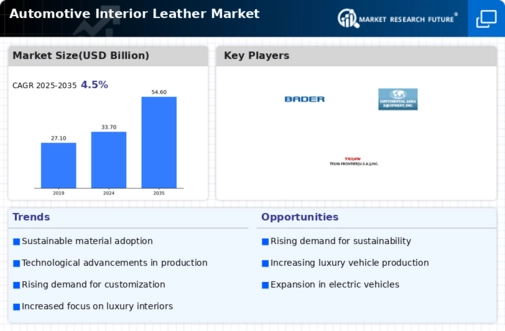Leading market players are investing heavily in research and development in order to expand their product lines, which will help the Automotive Interior leather market, grow even more. Market participants are also undertaking a variety of strategic activities to expand their footprint, with important market developments including new product launches, contractual agreements, mergers and acquisitions, higher investments, and collaboration with other organizations. To expand and survive in a more competitive and rising market climate, Automotive Interior leather Industry must offer cost-effective items.
Manufacturing locally to minimize operational costs is one of the key business tactics used by manufacturers in the Automotive Interior leather Industry to benefit clients and increase the market sector. In recent years, the Automotive Interior leather Industry has offered some of the most significant advantages to medicine. Major players in the Automotive Interior leather market, including GST AutoLeather Inc., Boxmark Leather GMBH & CO. KG, Midori Auto Leather CO., LTD., Bader Gmbh & Co.
Kg, Continental Ag, Nan Ya Plastics Corporation, Zhejiang, Hexin Holdings Co., Ltd., Teijin Limited, Gruppo Mastrotto Spa., and Asahi Kasei Corporation, are attempting to increase market demand by investing in research and development Materials.
Sage Car Interiors is one of the leading producers of vehicle Original Equipment Manufacturers (OEMs) with materials for automobile interiors, such as seating, door panel surfaces, and headliners. The continents of Asia, EMEA, South America, and the United States are among those with offices and factories on a scale. Sage's primary competencies include consumer research, sustainability, and inventive OEM problem solving. Sage wants to continually be at the forefront of the industry in terms of design, engineering, and technical ability, supported by first-rate production.
Sage Automotive Interiors' parent business is Asahi Kasei. synthetic leather producer and supplier In July 2022, Sage-ONF started mass production silicone synthetic leather for automobile interiors. The Sage-ONF plant in Shanghai, China, has started producing due to a high degree of customer demand.
FORVIA, the world's seventh largest automotive technology firm, today announced the launch of MATERI'ACT, a new brand dedicated to massively developing and manufacturing cutting-edge sustainable materials. FORVIA is the first in the automotive sector to have its "net zero emissions" goal certified by Science Based Target initiatives, bolstering its technological superiority in the field and allowing it to provide people with meaningful mobility experiences. MATERI'ACT creates, sources, manufactures, and sells new cutting-edge materials with low and ultra-low footprints, reducing CO2 emissions by up to 85% compared to current materials.
The product line comprises recycled, bio-based, and carbon-capturing compounds, bio-based foils, low-CO2 carbon fibers, and green steel for the automobile sector and beyond. MATERI'ACT's sustainable materials comply with the European Green Taxonomy.
Pangea, formerly known as GST Seton AutoLeather, is a leading supplier of leather to the automotive industry. We provide all-encompassing interior solutions that redefine supplier service standards. Our 5,000-person workforce, which is dispersed across four continents, is inspired by a well-controlled enthusiasm for leather. Our company, Connected by natureTM, is leading the way in the development of mobility interiors. visit communicate, go visit PangeaMade. One area of expertise is mobility interiors. In April 2019, GST AutoLeather Inc. inaugurated a brand-new leather finishing factory in Jiaxing.















Leave a Comment